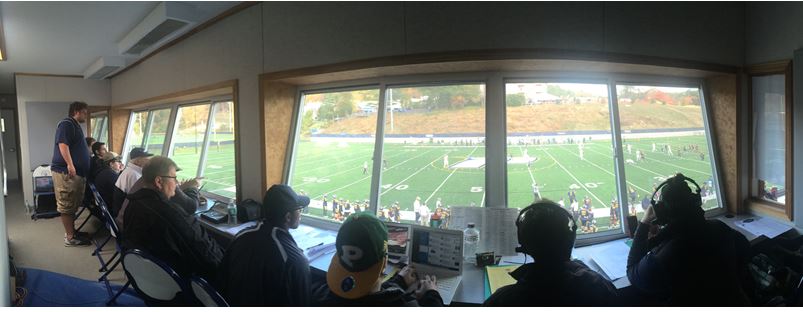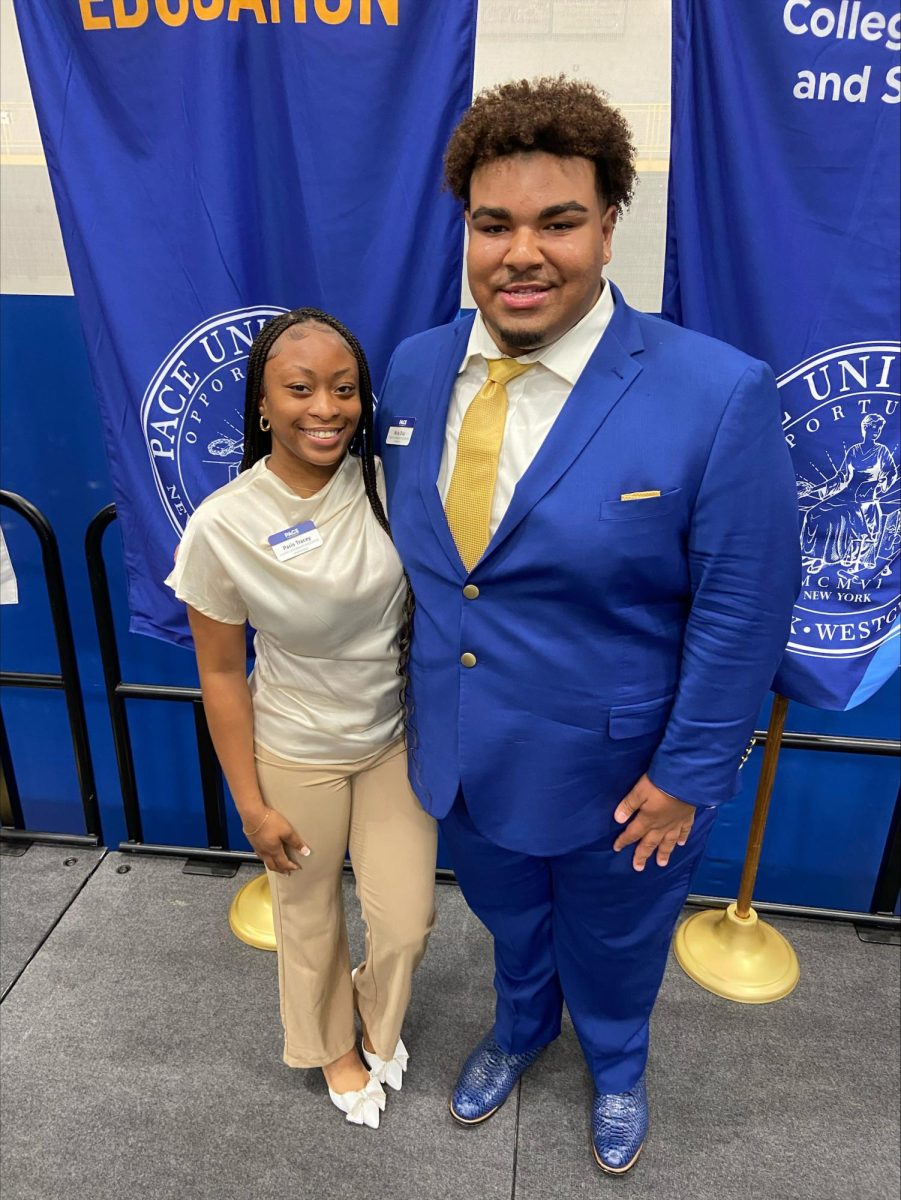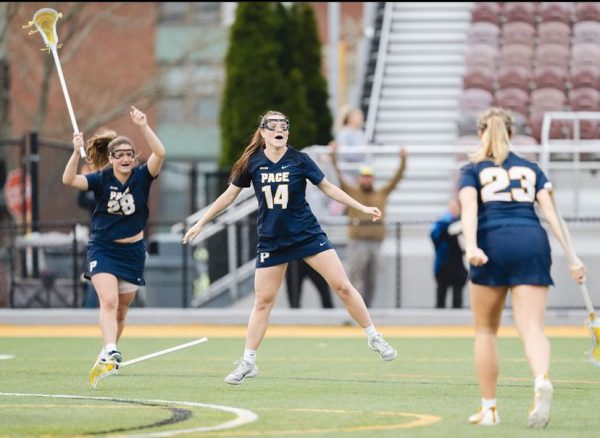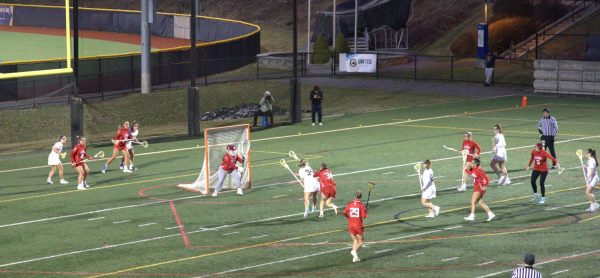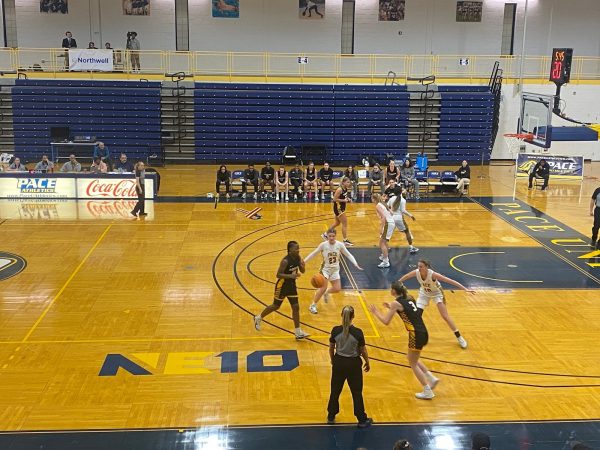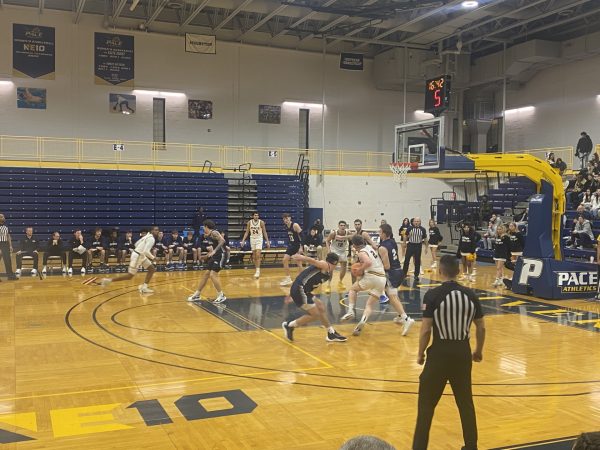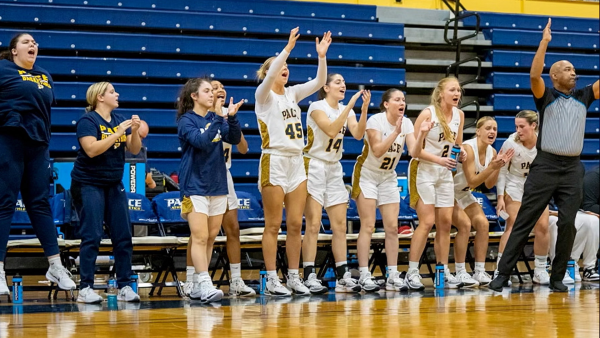Behind the Scenes: The Press Box
Photo by James Miranda/Pace Chronicle.
The view inside the press box of Pace Stadium. Graduate assistant Nick Thomas (standing) acts as the spotter to give PA announcer Tony Soares and others the immediate call on the play.
November 2, 2015
xHave you ever wondered what goes on in the press box at Pace Stadium? Besides having a good seat to watch the Setters play their sport, the crew in the press box play a sport of their own.
A small fraction of the team inside the press box is the public address (PA) announcer Tony Soares, the Assistant Athletic Director David Spiegel, the play-by-play announcer Mike McGinnis, and graduate assistant Nick Thomas.
Along with them are the Northeast-10 (NE-10) officials that control the clock and scoreboard, student assistants that control the camera for the live stream online, the opposing team’s sports information director/blogger, and coaches from both teams that transmit plays to the coaches on the field.
The process starts anew immediately after the final play of the game. At least for football, it is a weeklong process.
“When the week starts, we have our list we know what we need to get done,” Spiegel said. “We have our rosters and depth charts ready to go. We have to make sure that everything for the coaches are ready as well as the opposing team.”
During the week, the athletic department has to start getting programs and brochures ready, testing the microphones for the field and referees; scripts are drawn for the PA announcer, and interviews for the broadcasts are convened.
McGinnis has to collect his background information, interviews, roster, and depth charts for the broadcast. It is much the same for Soares who readies paperwork and is given a timeline for pregame.
“A typical week starts the day after the last game,” McGinnis said. “It’s five days of prep work. You have to do all your game notes, rosters, and talk coaches or media staff.”
Getting ready is the tedious part. Game day is putting everything together and working as a team to get everything done.
“It’s a big process, but if you put in the time, everything seems to work really well,” Spiegel said.
For the football team staff, the day starts around seven or eight a.m. From there, a lot of wiring is laid out to get Internet flowing smoothly, work stations and cameras are setup, microphones for the referees and other pregame announcements are checked, and the scoreboards are checked at least an hour and a half before game time.
Then the game starts.
“I hear [everything] in the background because I’m so focused on what’s going on in the game,” McGinnis said. “There’s a lot of yelling, there’s a lot of things going on, there’s about 30-to-40 people trying to get this thing to look perfect.”
If a fan ever pondered how Soares announces the player number and the yards after a play so quickly, it is because Thomas is running around the press box spotting and calling out the play.
“I won’t sit down the entire game,” Thomas said. “Wherever the play is, if it’s on the right side, I’ll be on the right side of the [press] box. If someone on our team ran the ball, I’ll just say ‘No. 23 ran the ball, tackle by No. 26 at the Pace 30-yard line.’”
As Thomas calls out the information, Soares will refer to his roster sheets for names. The 18-year veteran has grown accustomed to being able to interpret what is going on, however. He also controls the mixer that controls the on field microphone and the speakers that play music.
“A few years ago I didn’t have a spotter, I had to know who was tackling and who was running,” Soares said. “Now, I don’t have to focus on who’s tackling all the time. The most important thing to get out is who ran the ball, who threw it, how many yards they gained, what’s the down and distance, and I can hear who the tackler is.”
Thomas’s calling out also applies to the person who is running the stat program for the online component. For the homecoming game last Saturday, Oct. 17, Spiegel worked stats as he updated the website after every play.
Usually, stat sheets are printed per quarter and after each half for the coaches.
Among the hectic vibe of running around and making sure everything’s up and running, the team is upbeat and full of sports talk and playful banter.
“You suck,” Soares jokingly said as spotter Thomas called out the wrong player number during the homecoming game.
They’re a team and pick each other up. For example, if a camera were to stop working one assistant is immediately jumping to get things back together. And if one post is abandoned to help another, there for sure is another to pick up any slack.
“We work as a team,” Spiegel said. “We got a bunch of guys around helping out. All hands on deck.”
Once the game finishes, McGinnis is packed up and leaves right away along with other non-Pace staff. The student assistants and everyone else stay after to clean up and put everything where it needs to be.
Then there is the game recap that’s written and posted to the athletics website following every game.
“We have to write up the recaps [for games] and sometimes that can be difficult depending on how the game goes,” Spiegel said. “If it was a bad loss, it’s not easy to write about a loss. Sometimes it’s a record-breaking win and you have to do some research after the game and find something. Say someone scored 75-points, is that a record for the school, conference, or division?”
Once all is said and done, it’s quiet in the press box, according to Spiegel.
For the crew it’s just a typical day at the office.
“But day-to-day, things change,” Spiegel said.

